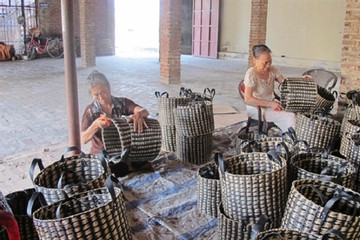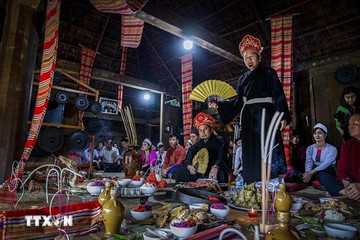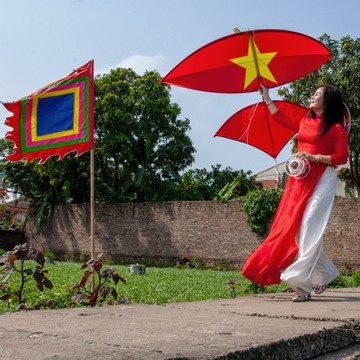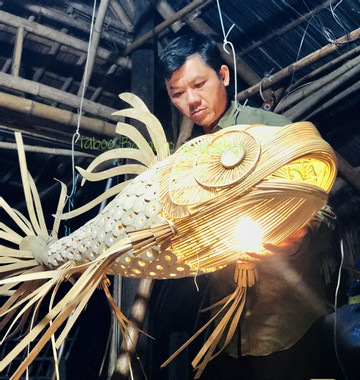- © Copyright of Vietnamnet Global.
- Tel: 024 3772 7988 Fax: (024) 37722734
- Email: evnn@vietnamnet.vn
vietnam's intangible heritage
Update news vietnam's intangible heritage
Two national intangible cultural heritages recognised in Hue
The Ministry of Culture, Sports and Tourism announced that on the list of national intangible heritages are the Huệ Nam Palace Festival and the traditional craft of making Vân Cù vermicelli.
Vietnam’s Ba Chua Xu Festival earns UNESCO recognition
The inclusion of the Ba Chua Xu Festival on UNESCO’s heritage list underscores its cultural value and the collective commitment to safeguarding Vietnam’s traditions.
Kylin dance to become part of intangible cultural heritage of humanity
HCM City has submitted a document to the Ministry of Culture, Sports and Tourism to name the art of kylin-lion-dragon dance by local people on the list of intangible cultural heritage of humanity of Vietnam.
Five crafts recognised as national intangible heritage
The Ministry of Culture, Sports and Tourism has announced five traditional crafts as national intangible heritage after recognizing a number of dishes from across the country recently.
Documentary heritage on brink of disappearing needs greater conservation efforts
Documentary heritage is a kind of cultural heritage, yet it has not been prescribed in the national legal system.
Village in Vietnam has three 'Memories of the World'
By 2023, nine Vietnamese heritage sites or artifacts had been recognized by UNESCO as Memories of the World (MOW); three of them are located in Truong Luu Village, Kim Song Truong commune, in Can Loc district in Ha Tinh province.
Kim Son sedge weaving named as intangible cultural heritage
Over 30,000 craftsmen are currently working in the Kim Sơn sedge weaving craft in the district, which accounts for around 80 per cent of the district’s yearly handcraft production value.
New decree protects intangible cultural heritage
The Government has issued a new decree stipulating measures to manage, protect and promote the value of intangible cultural heritage in the list of national items and of UNESCO.
VN prioritises safeguarding intangible cultural heritage in risk of being lost
Vietnam will prioritise the protection of intangible cultural heritage at risk of fading away or being lost, and those of ethnic communities living in far-flung areas, according a newly-issued Government decree.
Two intangible cultural heritage elements to seek inscription into world lists
Deputy Prime Minister Tran Hong Ha has agreed on the submission of the dossiers on “Mo Muong” and the “art of Cheo” to UNESCO to seek the inscription of these intangible cultural heritage elements into world lists.
VN announces new entrants on List of Intangible Cultural Heritage
A slew of new entrants is added onto the List of Intangible Cultural Heritage of Việt Nam in fields such as folk performing arts, traditional festivals, oral literature, scripts, and traditional handicrafts.
Five elements of Hanoi on new National List of Intangible Cultural Heritage
Heritage and ancient customs passed down from generation to generation are the precious legacies of the ancestors and must be well preserved.
Two more crafts recognised as national intangible heritage
The honor helps promote the community-based tourism and crafts in communes of Tan Hiep in Cham Islands, off the coast of Hoi An, and Cam Thanh in the suburban area.
Ministry announces new national intangible cultural heritage
Minister of Culture, Sports and Tourism Nguyen Van Hung has issued decisions on the inclusion of traditional performing arts, festivals, scripts and crafts, among others, in the list of national intangible cultural heritage.
Community fills gap in heritage preservation
Experts have affirmed the role of the local community as the "holder and practitioner" of heritage.
Southern fermented pork sausages recognised as national heritage
The taste of Lai Vung nem not only helps local households thrive, but also helps many people become rich.
Promoting Xoe Thai dance and Gong culture in the community
Artisans recently performed and shared about the special cultural heritage practices of the Northwest (Xoe dance of the Thai people) and Western regions (gong culture) at the Cultural and Arts Center at 22 Hang Buom Street, Hanoi.
Over 30 Vietnamese national intangible heritage added
Minister of Culture, Sports and Tourism Nguyen Van Hung has just signed a decision to list another 30 practices, representations and knowledge as national intangible cultural heritage.
Pa Then fire-jumping ceremony becomes national intangible heritage
“Nhảy lửa”, or fire jumping in English, a ritual of the Pa Then ethnic minority people in the mountainous province of Tuyen Quang, has been listed as part of Vietnam’s ’s intangible heritage for the second time.
Checkered history: Vietnam's traditional scarf weaving
The traditional craft of check scarf weaving was recognised as a National Intangible Cultural Heritage by the Ministry of Culture, Sports and Tourism.



















